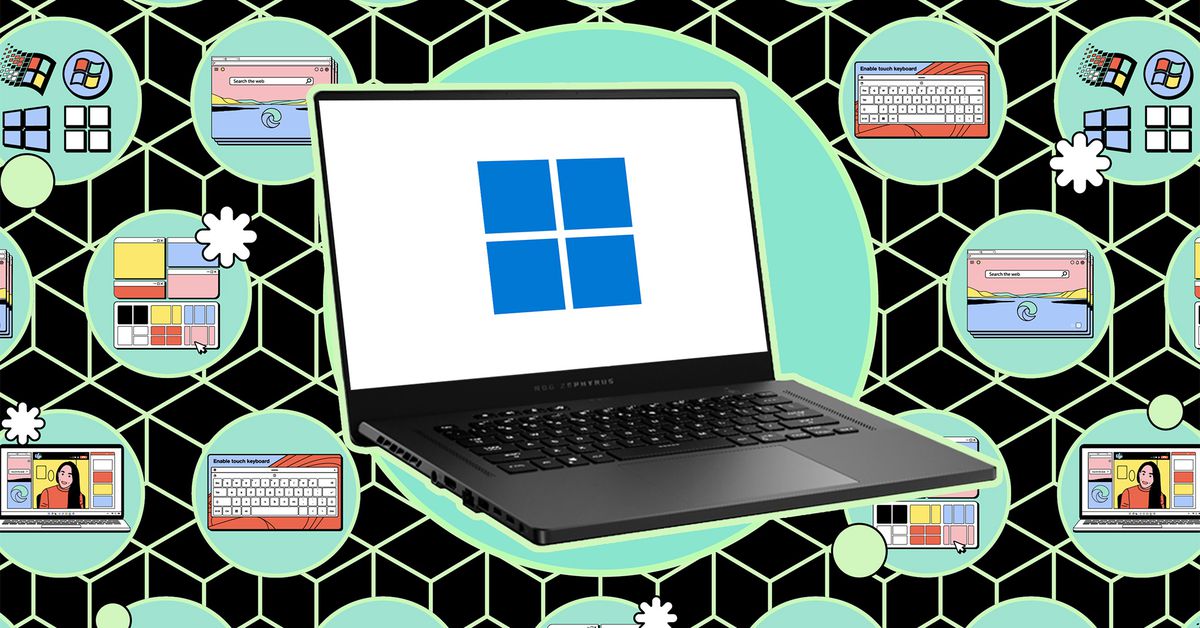Scratch the surface of Windows (and macOS), and you’ll find a command line console underneath, a lingering remnant of how these operating systems started out: as user-friendly graphical wrappers built on top of text-based, monochrome interfaces.
Technology
We need transparency from the companies disseminating misinformation


Here in the US, we are deep into election season, and it is impossible to debate politics without also debating how technology is distorting it. There are the AI-generated deepfake images Donald Trump circulated of Taylor Swift appearing to endorse his campaign, as well as disproven conspiracy theories about rigged voting machines. And then there are the malicious disinformation campaigns on social media, which are coming from everywhere – with seemingly no solutions in sight.
The Microsoft Threat Analysis Center released a report charting a recent rise in fake activist and news websites, as well as fake accounts on social media, created by operatives in Russia, Iran and China. Generally, their goals are to create chaos during the election and exacerbate tensions over race, gender and other hot-button cultural issues.
On X, Elon Musk released a chatbot called Grok, which was spouting misinformation for several weeks about when to vote. Meanwhile, Meta, owner of Facebook, announced it has a solution to the political misinformation conundrum: its social platform Threads won’t “recommend” political content. This is akin to claiming one can remove butter from shortbread – it sounds like a healthy goal until you try to separate out what is “political” from everything else.
I recently talked about all this at the National Book Festival in Washington DC on a panel with propaganda expert Peter Pomerantsev. Our moderator asked us if the 2024 election is better or worse than the 2020 one in terms of misinformation and disinformation, with the latter being false information intended to deceive or mislead. It is a complicated question, because social media has changed so much since 2020.
I think people are more aware of online misinformation, but they are more confused by it than ever. Partly that is because the previous generation of social platforms is crumbling away, and the new ones have fragmented us into dozens of spaces. But in the US, this confusion is also engineered. Politicians have sued and hamstrung academic groups like the Stanford Internet Observatory in California, which tracked US election misinformation online in 2020. We know the propaganda is out there, but nobody is able to analyse it adequately.
Plus, as Pomerantsev said, it isn’t as if online disinformation will evaporate after the elections. Indeed, many people crave it. Propaganda makes us feel like we are part of a community, united against a common enemy. This insight is particularly profound when it comes to social media, which is also designed to make people feel like they are part of a community even when they are alone with their glowing screen.
We are at a weird historical juncture. Experts may understand why propaganda works, but no longer know how it reaches us on a technical level. When the military sent propaganda to adversaries in the past century, they loaded pamphlets into planes and dropped them behind enemy lines. It was pretty obvious where the information was coming from, and why. Today, companies hide the way false information rockets across their platforms. Their algorithms for surfacing content are secret, and so are the identities of many people posting. We don’t need better technology to solve our misinformation problems; we need transparency from the companies disseminating it. They should be honest about where the content in our feeds is coming from, because most of what we see is determined by algorithm, and comes from strangers we never opted to follow. If researchers knew how information got into our feeds, and how people respond to it, they might come up with tools that prevent dangerous lies from spreading.
Still, there are non-technical solutions too. Bestselling author Rebecca Yarros, whose fantasy novel Fourth Wing is about a group of students at a war college for dragon riders, also spoke at the National Book Festival . As Yarros’s main character Violet gains more experience, she realises that the leaders of the college have been rewriting history books to justify a centuries-long war. In reality, her people started the war by colonising the group Violet once thought were the baddies.
Yarros explained that she wrote the book in part to protest US politicians who are removing references to slavery from history books. Many audience members thanked her for telling a story that debunked propaganda and was on the side of colonised people.
I walked around with a smile for a while afterwards. Partly it was the fizz of being in a real-life community, not one fabricated by propaganda. But it was more than that. Popular stories like Fourth Wing give me hope that the escape from propaganda can be just as compelling as the escape into it.
Annalee’s week
What I’m listening to
The podcast Tested, by Rose Eveleth, about the history and science of sex testing at the Olympics (see review, page 30)
What I’m reading
Peter Pomerantsev’s How to Win an Information War, a tale of British psychological operations in the second world war
What I’m working on
Learning about the history of biang biang noodles
Annalee Newitz is a science journalist and author. Their latest book is Stories Are Weapons: Psychological warfare and the American mind. They are the co-host of the Hugo-winning podcast Our Opinions Are Correct. You can follow them @annaleen and their website is techsploitation.com
Topics:
Technology
Here’s what a TV show based on Untitled Goose Game could have been like

Cast your mind back to 2019, when by the idea of terrorizing a quaint English village as a loud, annoying goose. , but it was fairly short and left me wanting more. In another universe, a TV adaptation would have happened already. While that didn’t quite pan out here, we do have a funny proof-of-concept to enjoy.
House House, the game’s developer, a “proof-of-concept for a hypothetical Untitled Goose Programme” on its YouTube channel on Friday. The studio created the short with Playdate maker and Untitled Goose Game publisher Panic and animation house Chromosphere Studio. It’s a great four-minute clip that’s well worth your time. It shows a goose bullying a journalist and groundskeeper during a TV interview. The art style is lovely, the Wallace and Gromit-esque humor is on point and the goose is just as much of a jerk as the one in the game.
Sadly, House House says that the show didn’t gain traction and those involved put the idea on the shelf. But at least we get this very amusing video out of it. If nothing else, it reminded me that I need to play the Panic-published , which seems
Science & Environment
North Korea: Women’s football’s sleeping giant

“Normally when there are 30 shots in the game, it is the United States with about 25 of ’em. Not today!”
It wasn’t just the ESPN commentator who was shocked.
Heather O’Reilly had scored the game’s final goal, dragging world number ones and two-time champions United States to a 2-2 draw in their opening match at the 2007 Women’s World Cup.
O’Reilly wasn’t surprised by the scoreline though. Or how evenly-fought the game was. She knew it would be tough.
Instead, as the final whistle blew, it was the attitude of the US’s opponents, who saw a chance missed, rather than a point gained, that struck her.
“I remember North Korea seeming disappointed,” says O’Reilly.
“Their body language seemed to say ‘oh my gosh, we were so close to taking down the giant’.”
North Korea is the world’s most isolated country, a state based around the infallibility of Supreme Leader Kim Jong-un and a deep suspicion of the outside world.
Yet, despite living standards being well behind most other nations, North Korea has been one of the strongest female football nations on the planet.
When they took on the United States in 2007, they were ranked fifth in the world and amid a run of three Asian titles in the space of a decade.
Their record at youth level is even better. In 2016, they won the U20 Women’s World Cup, defeating Spain, the United States and France in the knockout rounds. That same year, their under-17 team also lifted their age-grade World Cup.
“The game in 2007 was challenging, really super hard,” remembers O’Reilly of her meeting with North Korea’s senior side. “It was hard to get the ball off them, they were buzzing around, very quick.”
There was another challenge though, one that was unique to North Korea.
“It was just such a cloud of uncertainty,” says O’Reilly. “The film we had on them was very limited, even by the standard of the times.
“Every time we played North Korea, it was always a mystery.”
The mystery now is, after a doping controversy and a four-year absence from international football, can North Korea’s women be a force once again?
Technology
Ibotta’s CEO explains why startups shouldn’t try to time the IPO market

The IPO market has not roared back in 2024 as many investors hoped it would — not yet, at least. Elevated interest rates (this week’s 50 bps rate cut notwithstanding) and uncertainty related to the U.S. election have prompted many companies to stay private and wait for better market conditions.
But a handful of companies did go public this spring. Enterprise rewards platform Ibotta, which builds the backend rewards program infrastructure for enterprise clients like Walmart and Exxon, was one of them, debuting on the NYSE on April 18. Its IPO priced above its initial price range at $88 a share and debuted at $117 a share. It’s currently trading at $63 a share with a $1.7 billion market cap.
Ibotta’s CEO, Bryan Leach, told TechCrunch that five months after the IPO, he doesn’t regret taking his company public this year. Going public requires months of planning, and he thinks companies trying to time the market are making a “huge mistake.”
“Who knows what the [Federal Reserve] will do?” Leach said. “[Bankers say] it’s always better to wait, but you never know what will happen when you wait. At the end of the day, it’s not a destination, it’s a phase.”
Numerous companies that were expected to go public in 2022 or 2023 are still waiting on the sidelines. Many of these companies are sitting on large valuations that they gained from funding rounds during the boom days of 2021 and they would have to suffer a haircut to go public. There were 310 IPOs in the U.S. in 2021, according to PitchBook data. This has dropped sharply since. There were 80 in 2022, 85 in 2023 and 37 through the first half of 2024.
Leach admitted that some people consider the fact that Ibotta’s stock has dropped nearly 50% since its IPO as a sign that going public at this time wasn’t the right decision, or they might say that the company should have waited. Still, he feels it is too early to draw such conclusions, pointing to how Instacart’s stock is now trading close to its debut price — it hit a 52-week high today — a year after its IPO.
“Things are going great,” Leach said. “We are the largest tech IPO in Colorado history. The stock has gone way up, and gone down, and that sort of settles in over the course of the year. From a company perspective, we’ve been pleasantly surprised by how much value we got out of being a public company.”
Public companies also have an air of legitimacy around them, and Leach said that leverage is useful when it comes to nabbing potential enterprise customers. He said the company’s recent deal with Instacart may not have happened if Ibotta were still private.
“They trust us,” Leach said. “We have a certain amount of legitimacy. They know we have the resources. They can look at our finances. They can see we don’t have any debt. There is a level of comfort that [being a public company] provides.”
He added that the same level of legitimacy applies to hiring, too. Ibotta is no longer offering stock options tied to a private valuation given by investors with no downside protection, and Leach said that makes the company a more attractive option for talent.
Leach said companies on the fence about doing an IPO shouldn’t try to time the market, but they should wait until they are ready to be a public company.
Going public this April was not the company’s first choice, either. During the SPAC and IPO craze of 2020 and 2021, Ibotta’s investors began asking it to go public, and so the company hired bankers and wrote up an S-1, an SEC document that kicks off the IPO process. It was ready to set out on an IPO roadshow in fall of 2021 but decided to hold off.
Ibotta had landed a large deal with Walmart to run a white-label version of its rewards program at the time, Leach said, but he wanted to be able to prove the deal was actually working before going public. Not everyone was pleased with the company’s decision to wait.
Still, Leach feels it was the right choice. Waiting until 2024 allowed Ibotta to go public with six quarters of profitability behind it and get its finances in order. Other late-stage companies in the same boat, he thinks, shouldn’t wait around for a “better” market.
Investors don’t seem to mind companies waiting it out — at least they aren’t expressing otherwise publicly. But the IPO market is bound to open again eventually. Interest rates have started to go down and there is an increase in rumors surrounding companies hiring bankers to start the IPO process. Companies may be done waiting come 2025.
Science & Environment
𝙕𝙚𝙚𝙡 𝘾𝙡𝙤𝙩𝙝𝙞𝙣𝙜 𝙒𝙤𝙢𝙚𝙣'𝙨 𝘼𝙧𝙩 𝙎𝙞𝙡𝙠 𝙎𝙚𝙢𝙞-𝙎𝙩𝙞𝙩𝙘𝙝𝙚𝙙 𝙇𝙚𝙝𝙚𝙣𝙜𝙖 𝘾𝙝𝙤𝙡𝙞 𝙬𝙞𝙩𝙝 𝘿𝙪𝙥𝙖𝙩𝙩𝙖 (7801-𝙉𝙚𝙤𝙣-𝙒𝙚𝙙𝙙𝙞𝙣𝙜-𝘽𝙧𝙞𝙙𝙖𝙡

लिऺक नीचे दिया है
दिया है
Zeel Clothing Women’s Art Silk Semi-Stitched Lehenga Choli with Dupatta (7801-Neon-Wedding-Bridal-Latest; Free Size)
𝘾𝙡𝙞𝙘𝙠 𝙡𝙞𝙣𝙠 𝙩𝙤 𝙗𝙪𝙮
https://amzn.to/3FIvfYm
Lehenga Fabric: Art Silk; Blouse Fabric: Art Silk; Dupatta Fabric: Net; Inner: Satin with Cancan(tulle) layered net
Lehenga Work: Zari, Dori & Sequins Embroidery; Blouse Work: Dori, Zari & Glitter Sequins Embroidery; Dupatta Work: Zari, Dori & Sequins Embroidery
Measurements: Lehenga(Semi-Stitched) Flair : 4.50mtr, waist-43″, height-43″; Blouse(Unstitched) Size: up to 44″; Dupatta Length: 2.25 mtr
Package Contains: 1 Semi-Stitched Lehenga with Dupatta and unstitched 𝘽𝙡𝙤𝙪𝙨𝙚
#bridallahenga #youtube #shorts #viral 
𝙎𝙪𝙗𝙨𝙘𝙧𝙞𝙗𝙚 𝙩𝙝𝙞𝙨 𝙘𝙝𝙖𝙣𝙣𝙚𝙡 𝙩𝙤 𝙜𝙤
https://youtube.com/channel/UCBw_LRLVzAD4agHnNuBWv3Q
𝙁𝙤𝙡𝙡𝙤𝙬 𝙪𝙨 𝙤𝙣:
https://www.facebook.com/101006884746219/posts/406187564228148/
𝙁𝙤𝙡𝙡𝙤𝙬 𝙪𝙨 𝙤𝙣:
https://www.instagram.com/reel/CUQBuwclcS7/?utm_medium=cop
Technology
How to use Windows Terminal and what it’s useful for

If you’re as old as I am, you might remember having to launch apps and games on a computer by typing out text commands, rather than pointing and clicking. The modern-day methods are much easier, of course, but the old ways are still available — and they’re actually still useful for multiple tasks, as the list below shows.
To begin with, Windows kept the Command Prompt utility as a reminder of its MS-DOS roots. That was later joined by PowerShell (Command Prompt with extras), and in the latest versions of Windows 11, Command Prompt and PowerShell are now both wrapped up in a tool called Windows Terminal.
Windows Terminal supports all the original Command Prompt instructions, and you can launch it from the Start menu. It’s simple:
- Search for Terminal.
- Right-click on the program icon and choose Run as administrator to make sure all of the features are available to you.
Now that you’ve got the Windows Terminal open, here are some of the commands that might make it worth your while. To make use of them, type the text shown and then hit Enter.
1. Shut down your computer after a certain time
Shutting down your computer via the Start menu isn’t difficult, of course, but Terminal gives you a few more options, like timed shutdowns. The command above orders a shutdown (“/s”) rather than a restart, after a time (“/t”) of 600 seconds. Simply adjust the timing as needed.
Another handy option is “shutdown -r -o” (without the quotes), which restarts (“-r”) your computer and launches the Advanced Start Option menu — very useful for troubleshooting. Just type “shutdown” by itself to see other flags you can use.
2. See a visualization of your folders
Type “tree” and hit Enter to see a visual representation of the folders and subfolders on your system — very useful for seeing how your Windows drive is organized. You can include a drive and folder path (such as. “C:Programs”) to focus the listing on a specific area of the drive and use the “/f” flag to see files listed as well as folders.
3. Troubleshoot network problems
The “ipconfig” command is often used to troubleshoot networking problems. Use it on its own, and you’ll see your router’s current IP address, but add the “/flushdns” flag, and connections between your computer and the websites you visit get reset (via the DNS server), which can help if websites aren’t loading up as they should.
You can also use “ipconfig /release” and then “ipconfig /renew” to get a fresh IP address for your computer — potentially solving connection problems between your Windows device and your router or your device and the internet.
4. Get more information about your system
The classic “systeminfo” command will tell you just about everything you could possibly want to know about your system and then some: it returns your Windows 11 version and CPU model, the amount of RAM and storage installed, all the active network connections currently detected, and even how long your PC took to boot up last time around.
5. Check your Windows 11 drive for errors
The “chkdsk” command has long been a favorite of IT technicians, and you’ll see it appear in many a troubleshooting guide. It essentially checks your system disk for errors and can fix some of the most fundamental ones. For example, if you’re having trouble accessing files and folders, or booting up your PC, chkdsk might be able to help.
There are lots of flags you can use with it, too. The command on its own just looks for errors, but add a space and “/r” at the end, and the utility will try and fix those errors while recovering all the data it can. Use “chkdsk /?” to see other options.
The “tasklist” command gives you more or less the same information as the Task Manager, showing you which applications are putting the most strain on your system. Using the process ID numbers (or PIDS) that it shows, you can then forcefully kill apps using “taskkill /pid <PID number> /f” — which can be handy for troublesome software.
7. Analyze the energy states of your computer
This is another classic command line prompt, which, with the “/a” flag, will return all the sleep states your computer supports (such as hibernate and fast startup). You can also get a detailed battery report via “powercfg /batteryreport” — which is saved in the default folder for the current user account.
Dig deeper and there’s more: “powercfg /devicequery s1_supported” lists all the devices connected to your system that can wake it out of standby, for example. Change that “s1” if you need to analyze a different standby state — the codes will be listed when you run the original “powercfg /a” command.
8. Check Windows 11 system integrity
Like many other command line prompts, this one is really useful when it comes to troubleshooting. It checks the integrity of key operating system files and applies fixes where necessary. If you’re noticing bugs and crashes all across Windows 11, this is one of the first steps that a lot of troubleshooting guides will recommend.
9. Get advanced networking information
Another simple word that conceals a host of useful diagnostic utilities: Use “netstat” on its own and it’ll tell you about all the devices your computer is connected to, from printers to smart speakers (use Ctrl+C when you want it to stop).
Like many other commands, you can tweak the command in a myriad of ways (use “netstat /?” for a full list). You can, for example, use “netstat -b” to see which apps are currently communicating with the web, which can help spot programs that are being more active online than perhaps they should be.
Science & Environment
Peter Jay – the rise and fall of ‘the cleverest young man in England’ – WordupNews

HSBC’s exposure to defaulted commercial property loans in Hong Kong surged almost sixfold to more than $3bn in the first half of this year, underscoring the risks the UK bank faces from a slump in the Chinese territory’s real estate market.
The London-headquartered bank had $3.2bn in “credit impaired” commercial real estate loans to Hong Kong clients as of June 30, up from just $576mn six months earlier, according to its financial report for the first half of this year.
Hong Kong is HSBC’s largest market for commercial real estate lending, accounting for 45 per cent of its exposure, in comparison with 18 per cent for the UK.
The bank’s total global commercial real estate lending was $79bn as of June. The $3.2bn in credit impaired loans made up 9 per cent of HSBC’s total Hong Kong commercial real estate lending.
The leap in defaults is a sign of how the commercial property downturn in Hong Kong, a financial hub that has for years been one of the world’s most expensive real estate markets, has started to hit banks. Prime office rents have fallen more than 35 per cent since 2020, according to commercial property adviser Cushman & Wakefield.
While banks have been under pressure for several years over their exposure to mainland China’s property market, the focus is now shifting to Hong Kong, said David Wong, head of North Asia bank ratings at Fitch.
“We’re a lot more comfortable saying a line has been drawn under [banks’ exposure to] China commercial real estate, versus Hong Kong,” Wong said. “I don’t think we’ve seen the bottom yet.”
Under the bank’s definition, those borrowers have breached the terms of their loan. That can include missing payments but it can also include “non-financial” measures such as the loan-to-value ratio missing an agreed target figure.
Georges Elhedery, who became HSBC’s chief executive in September, said on a call with analysts in early August when he was chief financial officer that the loans were “all performing” even though “a large number” were classed as credit impaired.
However, the bank said “certain borrowers have sought payment deferrals to accommodate debt serviceability challenges” in its financial report for the first half of this year, published on July 31.
HSBC told the Financial Times this week that “a lot” of the borrowers are still paying interest. A spokesperson for the bank declined to provide figures on how many borrowers were paying interest or to offer more detail on Elhedery’s comment.

Standard Chartered, which as with HSBC has more exposure to commercial property lending in Hong Kong than any other region, reported a rise in the proportion of lower-rated borrowers in its most recent earnings, though it did not mark any of the loans as credit impaired.
The lender has cut its unsecured exposure to Hong Kong commercial real estate borrowers by 19 per cent since the end of 2022, it said in filings in July. Standard Chartered declined to comment.
Higher interest rates have put Hong Kong borrowers under pressure at a time when demand for office and retail space has fallen, with China’s economic slowdown and Beijing’s national security crackdown hitting international investor confidence. Tough zero-Covid measures also prompted an exodus of foreign workers during the pandemic.
The HSBC figures show that Hong Kong groups accounted for 45 per cent of the bank’s total credit-impaired commercial real estate lending as of June, up from 13 per cent six months earlier.
Elhedery said on the earnings call that the bank had taken a “probably prudent approach” in reclassifying the loans and was “comfortable and confident in the medium-to-long-term outlook” for Hong Kong’s commercial real estate sector, which would benefit from any rate cuts.
The bank said in its filing that its collateral coverage was strong and “broadly stable” even as valuations fell, and it was making “relatively low” provisions for credit losses on the loans because of high collateralisation.
“I think for those of us living in Hong Kong you can see vacancy rates are higher at this point,” said Ming Lau, the bank’s Asia chief financial officer, on the analyst call. But he said that the loans were structured so that the bank had recourse to “other assets and cash” of the borrowers.
Eleven of Hong Kong’s biggest property developers have written down the value of their investment property portfolios by about $23bn since 2020, according to data compiled by UBS for the Financial Times.
Mark Leung, a property analyst at UBS, said there could be more writedowns for Hong Kong’s developers in the near future. “For offices, rent probably will continue to come down due to the inflated supply issue, and vacancies could edge up,” he said.
Many of the territory’s property companies are controlled by tycoons and their families. Sun Hung Kai Properties is controlled by the Kwok family, Henderson Land Development by the Lee family, CK Asset by the Li family and New World Development by the Cheng family.
Gary Ng, a senior economist at Natixis, said that while the developers are expected to remain under pressure, most retained “sound financial positions” and could tap “old money” held by the tycoons and their families.
-

 News4 days ago
News4 days agoYou’re a Hypocrite, And So Am I
-

 Sport3 days ago
Sport3 days agoJoshua vs Dubois: Chris Eubank Jr says ‘AJ’ could beat Tyson Fury and any other heavyweight in the world
-

 CryptoCurrency3 days ago
CryptoCurrency3 days agoEthereum is a 'contrarian bet' into 2025, says Bitwise exec
-

 Technology4 days ago
Technology4 days agoWould-be reality TV contestants ‘not looking real’
-

 Science & Environment4 days ago
Science & Environment4 days agoHow to unsnarl a tangle of threads, according to physics
-

 CryptoCurrency3 days ago
CryptoCurrency3 days agoDorsey’s ‘marketplace of algorithms’ could fix social media… so why hasn’t it?
-

 CryptoCurrency3 days ago
CryptoCurrency3 days agoDZ Bank partners with Boerse Stuttgart for crypto trading
-

 CryptoCurrency3 days ago
CryptoCurrency3 days agoLow users, sex predators kill Korean metaverses, 3AC sues Terra: Asia Express
-

 News3 hours ago
News3 hours agoOur millionaire neighbour blocks us from using public footpath & screams at us in street.. it’s like living in a WARZONE – WordupNews
-

 Science & Environment3 days ago
Science & Environment3 days ago‘Running of the bulls’ festival crowds move like charged particles
-

 News3 days ago
News3 days agoIsrael strikes Lebanese targets as Hizbollah chief warns of ‘red lines’ crossed
-

 CryptoCurrency3 days ago
CryptoCurrency3 days agoBitcoin miners steamrolled after electricity thefts, exchange ‘closure’ scam: Asia Express
-

 CryptoCurrency3 days ago
CryptoCurrency3 days agoRedStone integrates first oracle price feeds on TON blockchain
-

 CryptoCurrency3 days ago
CryptoCurrency3 days agoBitcoin bulls target $64K BTC price hurdle as US stocks eye new record
-

 CryptoCurrency3 days ago
CryptoCurrency3 days agoVitalik tells Ethereum L2s ‘Stage 1 or GTFO’ — Who makes the cut?
-

 CryptoCurrency3 days ago
CryptoCurrency3 days agoBlockdaemon mulls 2026 IPO: Report
-

 Science & Environment3 days ago
Science & Environment3 days agoQuantum ‘supersolid’ matter stirred using magnets
-

 Sport3 days ago
Sport3 days agoUFC Edmonton fight card revealed, including Brandon Moreno vs. Amir Albazi headliner
-

 Science & Environment3 days ago
Science & Environment3 days agoHyperelastic gel is one of the stretchiest materials known to science
-

 Science & Environment3 days ago
Science & Environment3 days agoQuantum forces used to automatically assemble tiny device
-

 Health & fitness4 days ago
Health & fitness4 days agoThe secret to a six pack – and how to keep your washboard abs in 2022
-

 CryptoCurrency3 days ago
CryptoCurrency3 days agoCardano founder to meet Argentina president Javier Milei
-

 CryptoCurrency3 days ago
CryptoCurrency3 days agoCertiK Ventures discloses $45M investment plan to boost Web3
-

 CryptoCurrency3 days ago
CryptoCurrency3 days agoVonMises bought 60 CryptoPunks in a month before the price spiked: NFT Collector
-

 CryptoCurrency3 days ago
CryptoCurrency3 days agoSEC asks court for four months to produce documents for Coinbase
-

 CryptoCurrency3 days ago
CryptoCurrency3 days ago‘Silly’ to shade Ethereum, the ‘Microsoft of blockchains’ — Bitwise exec
-

 CryptoCurrency3 days ago
CryptoCurrency3 days ago‘No matter how bad it gets, there’s a lot going on with NFTs’: 24 Hours of Art, NFT Creator
-

 CryptoCurrency3 days ago
CryptoCurrency3 days agoCoinbase’s cbBTC surges to third-largest wrapped BTC token in just one week
-

 Technology3 days ago
Technology3 days agoiPhone 15 Pro Max Camera Review: Depth and Reach
-

 Science & Environment3 days ago
Science & Environment3 days agoHow one theory ties together everything we know about the universe
-

 Science & Environment3 days ago
Science & Environment3 days agoSunlight-trapping device can generate temperatures over 1000°C
-

 News3 days ago
News3 days agoBrian Tyree Henry on voicing young Megatron, his love for villain roles
-

 Science & Environment4 days ago
Science & Environment4 days agoTime travel sci-fi novel is a rip-roaringly good thought experiment
-

 Science & Environment4 days ago
Science & Environment4 days agoLaser helps turn an electron into a coil of mass and charge
-

 Science & Environment4 days ago
Science & Environment4 days agoITER: Is the world’s biggest fusion experiment dead after new delay to 2035?
-

 Science & Environment4 days ago
Science & Environment4 days agoLiquid crystals could improve quantum communication devices
-

 Science & Environment4 days ago
Science & Environment4 days agoHow to wrap your mind around the real multiverse
-

 Science & Environment3 days ago
Science & Environment3 days agoPhysicists are grappling with their own reproducibility crisis
-

 Science & Environment3 days ago
Science & Environment3 days agoNuclear fusion experiment overcomes two key operating hurdles
-

 CryptoCurrency3 days ago
CryptoCurrency3 days ago$12.1M fraud suspect with ‘new face’ arrested, crypto scam boiler rooms busted: Asia Express
-

 CryptoCurrency3 days ago
CryptoCurrency3 days agoEthereum falls to new 42-month low vs. Bitcoin — Bottom or more pain ahead?
-

 CryptoCurrency3 days ago
CryptoCurrency3 days agoETH falls 6% amid Trump assassination attempt, looming rate cuts, ‘FUD’ wave
-

 CryptoCurrency3 days ago
CryptoCurrency3 days agoBitcoin options markets reduce risk hedges — Are new range highs in sight?
-

 News3 days ago
News3 days agoChurch same-sex split affecting bishop appointments
-

 Politics5 days ago
Politics5 days agoTrump says he will meet with Indian Prime Minister Narendra Modi next week
-

 Science & Environment4 days ago
Science & Environment4 days agoWhy this is a golden age for life to thrive across the universe
-

 Technology4 days ago
Technology4 days agoCan technology fix the ‘broken’ concert ticketing system?
-

 Politics3 days ago
Politics3 days agoLabour MP urges UK government to nationalise Grangemouth refinery
-

 Science & Environment4 days ago
Science & Environment4 days agoMaxwell’s demon charges quantum batteries inside of a quantum computer
-

 Science & Environment4 days ago
Science & Environment4 days agoQuantum time travel: The experiment to ‘send a particle into the past’
-

 CryptoCurrency3 days ago
CryptoCurrency3 days ago2 auditors miss $27M Penpie flaw, Pythia’s ‘claim rewards’ bug: Crypto-Sec
-

 CryptoCurrency3 days ago
CryptoCurrency3 days agoHelp! My parents are addicted to Pi Network crypto tapper
-

 CryptoCurrency3 days ago
CryptoCurrency3 days agoCrypto scammers orchestrate massive hack on X but barely made $8K
-

 Science & Environment3 days ago
Science & Environment3 days agoWhy we need to invoke philosophy to judge bizarre concepts in science
-

 CryptoCurrency3 days ago
CryptoCurrency3 days agoSEC sues ‘fake’ crypto exchanges in first action on pig butchering scams
-

 CryptoCurrency3 days ago
CryptoCurrency3 days agoBitcoin price hits $62.6K as Fed 'crisis' move sparks US stocks warning
-

 CryptoCurrency3 days ago
CryptoCurrency3 days agoCZ and Binance face new lawsuit, RFK Jr suspends campaign, and more: Hodler’s Digest Aug. 18 – 24
-

 CryptoCurrency3 days ago
CryptoCurrency3 days agoBeat crypto airdrop bots, Illuvium’s new features coming, PGA Tour Rise: Web3 Gamer
-

 CryptoCurrency3 days ago
CryptoCurrency3 days agoMemecoins not the ‘right move’ for celebs, but DApps might be — Skale Labs CMO
-

 CryptoCurrency3 days ago
CryptoCurrency3 days agoTelegram bot Banana Gun’s users drained of over $1.9M
-
Politics3 days ago
The Guardian view on 10 Downing Street: Labour risks losing the plot | Editorial
-

 Politics3 days ago
Politics3 days agoI’m in control, says Keir Starmer after Sue Gray pay leaks
-
Business3 days ago
How Labour donor’s largesse tarnished government’s squeaky clean image
-
Politics3 days ago
‘Appalling’ rows over Sue Gray must stop, senior ministers say | Sue Gray
-
Business3 days ago
UK hospitals with potentially dangerous concrete to be redeveloped
-

 News3 days ago
News3 days agoSean “Diddy” Combs denied bail again in federal sex trafficking case
-

 Technology3 days ago
Technology3 days agoFivetran targets data security by adding Hybrid Deployment
-
Politics5 days ago
Starmer ally Hollie Ridley appointed as Labour general secretary | Labour
-

 Money4 days ago
Money4 days agoWhat estate agents get up to in your home – and how they’re being caught
-

 Business5 days ago
Business5 days agoGuardian in talks to sell world’s oldest Sunday paper
-
News3 days ago
Freed Between the Lines: Banned Books Week
-

 MMA3 days ago
MMA3 days agoUFC’s Cory Sandhagen says Deiveson Figueiredo turned down fight offer
-

 MMA3 days ago
MMA3 days agoDiego Lopes declines Movsar Evloev’s request to step in at UFC 307
-

 Football3 days ago
Football3 days agoSlot's midfield tweak key to Liverpool victory in Milan
-

 Science & Environment3 days ago
Science & Environment3 days agoHow to wrap your head around the most mind-bending theories of reality
-

 Fashion Models3 days ago
Fashion Models3 days agoMiranda Kerr nude
-

 Fashion Models3 days ago
Fashion Models3 days ago“Playmate of the Year” magazine covers of Playboy from 1971–1980
-

 News6 days ago
News6 days agoDid the Pandemic Break Our Brains?
-

 Politics5 days ago
Politics5 days agoTrump Media breached ARC Global share agreement, judge rules
-

 Science & Environment3 days ago
Science & Environment3 days agoA new kind of experiment at the Large Hadron Collider could unravel quantum reality
-

 Fashion Models3 days ago
Fashion Models3 days agoMixte
-

 Science & Environment3 days ago
Science & Environment3 days agoHow Peter Higgs revealed the forces that hold the universe together
-

 Science & Environment3 days ago
Science & Environment3 days agoOdd quantum property may let us chill things closer to absolute zero
-

 Science & Environment3 days ago
Science & Environment3 days agoRethinking space and time could let us do away with dark matter
-

 Entertainment3 days ago
Entertainment3 days ago“Jimmy Carter 100” concert celebrates former president’s 100th birthday
-

 News4 days ago
News4 days ago▶️ Media Bias: How They Spin Attack on Hezbollah and Ignore the Reality
-

 News4 days ago
News4 days agoRoad rage suspects in custody after gunshots, drivers ramming vehicles near Boise
-

 Science & Environment4 days ago
Science & Environment4 days agoNerve fibres in the brain could generate quantum entanglement
-
Business5 days ago
Glasgow to host scaled-back Commonwealth Games in 2026
-

 Science & Environment3 days ago
Science & Environment3 days agoX-ray laser fires most powerful pulse ever recorded
-

 Science & Environment3 days ago
Science & Environment3 days agoBeing in two places at once could make a quantum battery charge faster
-

 Health & fitness5 days ago
Health & fitness5 days agoWhat ‘elite sleepers’ can tell us all about the eight hour myth
-

 Science & Environment3 days ago
Science & Environment3 days agoWe may have spotted a parallel universe going backwards in time
-

 CryptoCurrency3 days ago
CryptoCurrency3 days agoTreason in Taiwan paid in Tether, East’s crypto exchange resurgence: Asia Express
-

 CryptoCurrency3 days ago
CryptoCurrency3 days agoJourneys: Robby Yung on Animoca’s Web3 investments, TON and the Mocaverse
-

 CryptoCurrency3 days ago
CryptoCurrency3 days agoLouisiana takes first crypto payment over Bitcoin Lightning
-

 CryptoCurrency3 days ago
CryptoCurrency3 days agoAre there ‘too many’ blockchains for gaming? Sui’s randomness feature: Web3 Gamer
-

 CryptoCurrency3 days ago
CryptoCurrency3 days ago‘Everything feels like it’s going to shit’: Peter McCormack reveals new podcast
-

 Science & Environment3 days ago
Science & Environment3 days agoA single atom could drive a piston in a quantum engine
-

 Science & Environment3 days ago
Science & Environment3 days agoTiny magnet could help measure gravity on the quantum scale

You must be logged in to post a comment Login